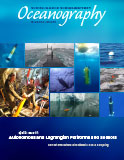Article Abstract
Saildrones are unmanned surface vehicles engineered for oceanographic research and powered by wind and solar energy. In the summer of 2016, two Saildrones surveyed the southeastern Bering Sea using passive acoustics to listen for vocalizations of marine mammals and active acoustics to quantify the spatial distribution of small and large fishes. Fish distributions were examined during foraging trips of northern fur seals (Callorhinus ursinus), and initial results suggest these prey distributions may influence the diving behavior of fur seals. The Saildrone is faster, has greater instrument capacity, and requires less support services than its counterparts. This innovative platform performed well in stormy conditions, and it demonstrated the potential to augment fishery surveys and advance ecosystem research.

